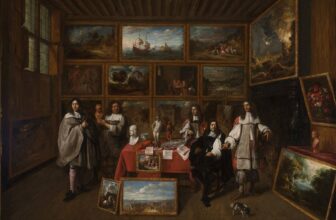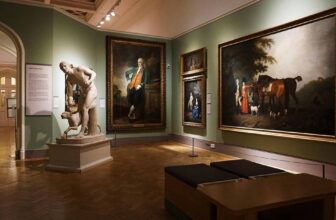
Art Investment as Part of a Creative Retirement Plan
Why Art Belongs in Your Retirement Strategy and How Art Can Fund Your Dream Retirement
Retirement planning has traditionally focused on a predictable trio: savings accounts, bonds, and the stock market. But as markets fluctuate, inflation impacts purchasing power, and interest rates rise and fall, a growing number of people are turning to alternative investments to secure their future. One of the most compelling , and often overlooked , of these alternatives is art investment.
Whether it’s paintings, photography, sculptures, or rare collectibles, fine art is no longer just for museums or billionaires. In fact, adding art to your retirement portfolio can offer diversification, long-term appreciation, tax advantages, and even personal enjoyment. For retirees seeking both financial security and a meaningful lifestyle, art can be a powerful asset class.
In this comprehensive guide, we’ll explore why art belongs in your retirement strategy, how art investing works, and how it can help fund your dream retirement.
The Rise of Art as an Investment Asset
Art has long been a symbol of culture, taste, and legacy. But in recent decades, it has also emerged as a serious investment category. Major auction houses like Sotheby’s and Christie’s regularly report record-breaking sales, with modern and contemporary works seeing consistent value appreciation.
According to the Deloitte Art & Finance Report, global art market sales surpassed $67 billion in recent years, and art has proven resilient even during times of economic volatility. Unlike stocks, which can plummet overnight, art often maintains its value and can even appreciate during inflationary periods.
Key reasons art has gained popularity among retirees and investors:
Tangible asset: Unlike digital or paper assets, art is physical, enduring, and portable.
Low correlation to traditional markets: Art values don’t necessarily move in lockstep with the stock market, making it an excellent diversification tool.
Cultural and emotional value: Art can bring joy, identity, and meaning to your retirement years while quietly growing in value.
Legacy potential: Art can be passed down to future generations or sold to fund life goals.
Why Art Belongs in Your Retirement Strategy
When designing a retirement strategy, one of the key principles is diversification , spreading your investments across different asset classes to reduce risk and increase potential returns. While most portfolios contain equities, bonds, and real estate, art investment offers unique advantages that make it an appealing addition.
Portfolio Diversification and Stability
A diversified portfolio is less vulnerable to market swings. During financial crises, while stocks and bonds may fall, fine art has often remained stable or recovered faster. This makes art a strategic hedge against economic uncertainty.
Inflation Hedge
Art has historically acted as a store of value. As inflation erodes the purchasing power of cash, tangible assets like gold, real estate, and art tend to maintain or increase their worth. This means that owning art can help preserve your wealth through your retirement years.
Potential for Capital Appreciation
Blue-chip artworks , pieces by well-established artists , can appreciate substantially over time. Even emerging artists can offer impressive returns when chosen wisely. For example, early buyers of works by Banksy saw their investments multiply as the artist’s fame skyrocketed.
Lifestyle Enhancement and Emotional Return
Unlike many other investments, art can enhance your everyday life. You can enjoy the beauty, inspiration, and personal connection your collection brings to your home. For retirees, this emotional value can be as important as financial gain.
Estate Planning and Legacy Building
Art can be an effective estate planning tool. It can be inherited, gifted, or donated to cultural institutions, often with tax advantages. This allows retirees to shape their legacy in meaningful ways.
How Art Investment Works: A Practical Overview
Before incorporating art into your retirement strategy, it’s essential to understand how the market functions. Art investment isn’t about randomly buying paintings , it involves research, due diligence, and a clear financial plan.
Primary vs. Secondary Market
Primary market: Buying directly from galleries or artists. Prices are often lower, and this can offer opportunities to invest early in emerging talents.
Secondary market: Buying at auctions, art fairs, or from collectors. Prices here reflect current market demand and artist reputation.
Types of Art Investments
Fine art (paintings, drawings, sculptures)
Photography and prints
Digital art and NFTs (in carefully chosen cases)
Limited-edition works
Collectibles (ceramics, textiles, installations, and more)
Holding Period
Art is typically a long-term investment. While quick flips can happen, most art appreciates steadily over time , often over 5–15 years. This fits well with a retirement strategy that values steady, patient growth.
Liquidity Considerations
Unlike stocks, art isn’t instantly liquid. Selling a piece may take weeks or months, depending on demand and venue. However, auction houses, online art platforms, and private sales have made art more liquid than ever before.
Building Your Retirement Art Portfolio
Building a smart art portfolio requires strategy, just like any other investment.
Define Your Budget and Goals
Before you buy your first piece, determine how much of your retirement savings you’re comfortable allocating to art. A common recommendation is between 5–15% of your portfolio.
Ask yourself:
Do you want income (through leasing, lending, or fractional ownership)?
Are you aiming for long-term appreciation?
Is emotional enjoyment part of your goal?
Start with Emerging Artists
You don’t need millions to invest in art. Many retirees start by purchasing works from promising emerging artists at affordable prices. If these artists gain recognition, the value of your investment can multiply.
Add Blue-Chip Pieces for Stability
Well-known artists or established movements offer stability. Though they come with a higher price tag, their values tend to be less volatile and can serve as anchors in your portfolio.
Use Art Advisors and Platforms
Navigating the art world can be complex. Trusted art advisors, galleries, or online platforms can help identify opportunities, authenticate works, and provide valuation services.
Diversify Within Art Itself
Just like in stock investing, don’t put all your eggs in one basket. Consider mixing media types, artists, and markets (local and international) to balance risk and return.
Funding Your Dream Retirement with Art
Art can be more than a beautiful asset , it can actively fund your retirement lifestyle.
Selling Appreciated Pieces
Selling part of your collection can provide significant lump sums to cover major expenses or fund travel, healthcare, or a second home. Strategic timing, often during market peaks, can maximize returns.
Leasing or Lending Your Art
You can lease your art to businesses, hotels, galleries, or public spaces for regular income. This turns your collection into a cash-flowing asset while you retain ownership.
Collateral for Loans
Many financial institutions offer loans secured by art. This allows you to tap into your art’s value without selling it , useful for covering retirement expenses or making new investments.
Tax Advantages Through Donations
Donating artwork to museums or cultural organizations can yield significant tax deductions. This can reduce your taxable income while contributing to your legacy.
The Role of Art Funds and Fractional Ownership
For retirees who don’t want to manage individual artworks, there are more hands-off ways to invest.
Art Investment Funds
Art funds pool capital from multiple investors to purchase high-value artworks. These funds are managed professionally and offer diversification, expert selection, and reduced entry barriers.
Fractional Ownership Platforms
Technology has opened the door to fractional art investing. Through regulated platforms, you can buy a share of a masterpiece , such as a painting by Pablo Picasso , for a fraction of its total price. This lets you participate in the market without needing millions.
Advantages for Retirees
Lower capital requirement
Professional management
Passive income opportunities
Easier liquidity compared to physical ownership
Managing Risks and Protecting Your Investment
Like any investment, art comes with risks. But these can be mitigated with smart planning.
Authenticity and Provenance
Always verify the authenticity of the artwork. Provenance (ownership history) is crucial. Use reputable galleries, auction houses, or third-party authentication services to avoid counterfeits.
Insurance and Storage
Protect your investment against theft, fire, or damage with proper insurance. Consider professional climate-controlled storage for valuable pieces to maintain their condition.
Market Volatility and Trends
The art market can be cyclical. Some styles or artists may fall out of favor. Diversify and avoid overpaying for “trendy” works that lack long-term staying power.
Legal and Tax Considerations
Art transactions can involve complex legal and tax issues, especially for high-value pieces. Consulting with tax professionals and legal advisors ensures compliance and can maximize after-tax returns.
Tax Benefits of Art Investing for Retirees
Tax planning is a crucial part of retirement strategy , and art investment can offer significant advantages.
Capital Gains Tax
When you sell a piece of art at a profit, it’s typically subject to capital gains tax. However, careful planning , such as holding for the long term or using charitable donations , can reduce the tax impact.
Estate Planning Strategies
Art can be strategically included in estate planning to minimize estate taxes. For example, placing art in trusts or donating pieces can help preserve wealth for heirs.
Charitable Deductions
Donating appreciated art to qualified organizations can provide a charitable deduction equal to the fair market value of the artwork, reducing taxable income.
Emotional and Lifestyle Benefits of Art Ownership
Financial returns are only part of the equation. For retirees, emotional and lifestyle enrichment matters too.
A Source of Daily Inspiration
Living surrounded by beautiful works you love can make your retirement years more meaningful. Many retirees report a sense of pride and joy in building a personal collection.
A Bridge to Community and Culture
Collecting art can connect you to artists, galleries, museums, and other collectors. This creates opportunities for social engagement, learning, and cultural enrichment.
A Creative Legacy
Art can outlive its owner. Passing down a collection or donating it to institutions creates a lasting impact that reflects your taste, vision, and values.
Real-World Examples: Art Funding Retirement Dreams
To understand the potential of art investing, let’s look at a few real-world stories (based on publicly available examples):
A retired couple purchased several prints by Andy Warhol in the 1980s for a few thousand dollars each. Decades later, the pieces appreciated significantly, enabling them to sell part of their collection to fund travel and home renovations.
An art enthusiast invested in emerging local artists early in their careers. As those artists gained recognition, the value of their works increased, allowing the collector to generate income by leasing them to hotels and offices.
An investor participated in a fractional ownership platform that acquired a painting by Claude Monet. Over several years, the piece appreciated, and when sold, the investor received a substantial return without ever handling the artwork physically.
Integrating Art Into a Broader Retirement Plan
Art should be part of a balanced strategy, not a replacement for traditional investments.
Work With a Financial Advisor
A financial advisor familiar with alternative assets can help ensure your art investments complement your overall goals, risk tolerance, and income needs.
Balance Liquidity and Growth
Because art is less liquid than stocks or bonds, maintain a healthy balance between liquid assets (cash, bonds) and art holdings.
Include Art in Estate and Tax Planning
Document your art collection clearly, with valuations and provenance records, to simplify estate planning and maximize potential tax benefits.
The Future of Art Investing and Retirement
The art investment landscape is evolving. Technological innovation, fractional ownership platforms, and increased transparency are making the art market more accessible than ever before.
Digital platforms allow retirees to browse and invest in art globally.
Blockchain technology offers improved provenance tracking.
Fractional investing lowers the entry barrier, allowing more retirees to diversify.
As the world shifts toward experience-driven lifestyles, retirees increasingly seek investments that are both financially rewarding and personally meaningful. Art sits at the perfect intersection of wealth preservation, lifestyle enrichment, and legacy creation.
Your Retirement, Your Masterpiece
Retirement planning is more than numbers in an account , it’s about building a future that aligns with your values, passions, and dreams. Incorporating art into your retirement strategy allows you to invest with both your head and your heart.
Art can diversify your portfolio, hedge against inflation, generate income, and enhance your everyday life. It can fund travel, experiences, and the freedom to live on your terms. Whether you invest in blue-chip masterpieces, emerging artists, or fractional shares of iconic works, art offers a unique pathway to financial security and personal fulfillment.
Your retirement years can be your most creative chapter. By making art investment a part of your financial plan, you’re not just securing your future , you’re curating it.
Frequently Asked Questions
1. Is art a safe investment for retirement?
While no investment is risk-free, art has historically shown resilience and appreciation over time, making it a valuable diversification tool in a balanced retirement portfolio.
2. How much should I allocate to art in my retirement plan?
Many experts recommend 5–15% of your portfolio, depending on your financial goals, risk tolerance, and liquidity needs.
3. How do I sell art in retirement to fund my lifestyle?
Options include auction houses, galleries, private sales, leasing, or fractional resale. Working with professionals ensures maximum value.
4. What about taxes when selling art?
Art sales can trigger capital gains tax. Proper planning , including holding periods, charitable donations, or trusts , can reduce tax liabilities.
5. Do I need millions to start investing in art?
No. You can start small by buying emerging artists or investing fractionally in high-value pieces.
6. What are the risks of art investing?
Risks include market fluctuation, authenticity issues, liquidity challenges, and maintenance costs. Mitigate these with research, insurance, and professional guidance.
Art investing is no longer reserved for the ultra-wealthy. It’s an accessible, inspiring, and potentially profitable way to enhance your retirement strategy. By carefully selecting pieces, diversifying your holdings, and integrating art into a broader financial plan, you can fund a fulfilling and secure retirement.
Retirement is your masterpiece , and art can be one of the brushstrokes that makes it extraordinary.




